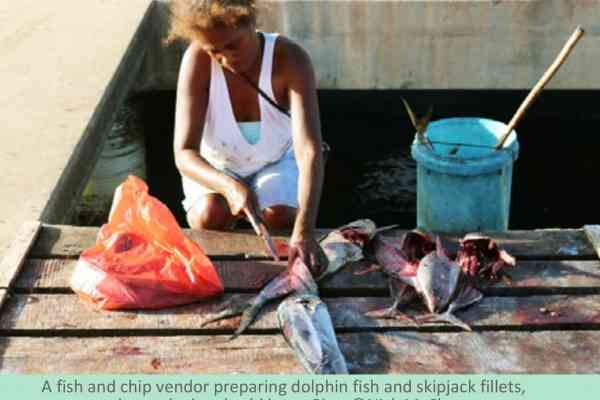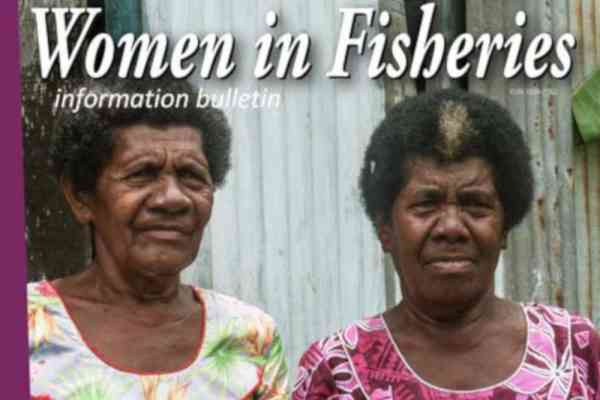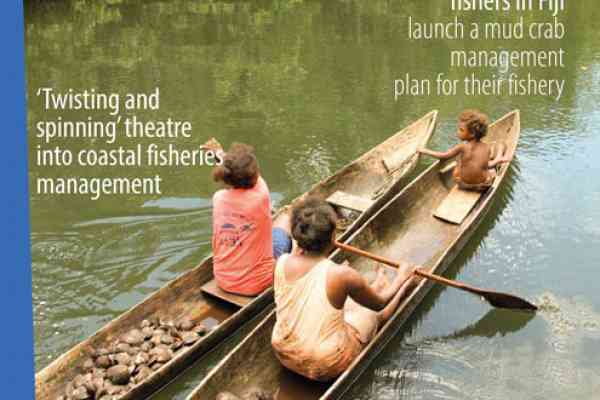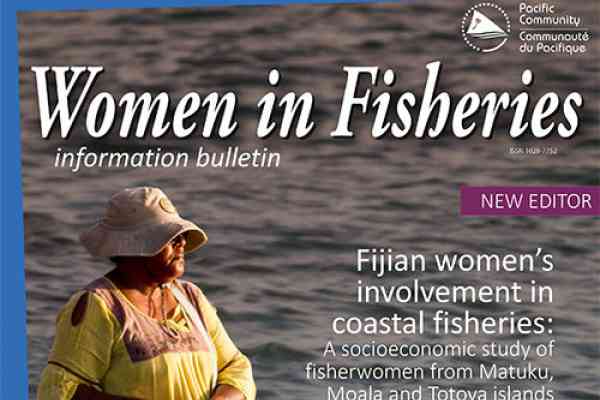By Alyssa S. Thomas, Sangeeta Mangubhai1, Margaret Fox, Watisoni Lalavanua, Semisi Meo, Waisea Naisilisili, Alfred Ralifo, Joeli Veitayaki and Salote Waqairatu
Men and women in fishing communities are often viewed as conforming to strict traditional roles (FAO 2017). A woman’s job can entail staying in or close to the village and carrying out household tasks, while men work beyond the village area with the responsibility of providing food and income for their households (Harper et al. 2013). This limited framing of gender roles has resulted in an underestimation of fisheries catches in inshore areas, in addition to an undervaluing of the important contributions women fishers make to not only their village but also the economy overall (Kleiber et al. 2014).
Worldwide, men and women also have different and often complementary roles in regard to their fishing. For example, women are more likely to fish freshwater habitats, soft bottom, and mangrove and mudflat habitats close to the village, and largely for subsistence (Kronen and Vunisea 2009; Lambeth et al. 2014). In comparison, coral reefs and offshore environments are more often fished by men (Lentisco and Lee 2015; Ram-Bidesi 2015). In terms of species targeted, women generally focus on harvesting nonfinfish (e.g. invertebrates and seaweeds), whereas the men concentrate on catching finfish and select species with a high dollar value (Vunisea 2014). In Fiji, most women fishers are generalists, collecting and selling a wide range of species. The more valuable species are taken to markets to sell (if possible), or sold to middlemen or other buyers in the village. Historically, women’s involvement in fisheries was mainly at the household subsistence level, although an increasing number are involved in commercial fisheries (Fay-Sauni et al. 2008; Vunisea 1997). However, women wanting to fish for income face the challenge of needing to find the time to complete their traditionally assigned chores as well as selling their seafood catch (Vunisea 2014).
Despite research efforts to date, there still lacks an accurate perception of women in the fisheries sector (Lambeth et al. 2014); their unique needs and/or perspectives are not routinely incorporated into fisheries management and policy decisions (FAO 2017). An improved understanding of gender roles can therefore allow interventions to be tailored to specific groups of fishers and thus be more effective (Vunisea 2014). In response to these information needs, a national study of fisheries-dependent communities was conducted to better understand and highlight the role of women fishers in the Fijian inshore fisheries sector. Fisheriesdependent communities were surveyed to gain a “better understanding and quantification of the role of indigenous (iTaukei) women fishers in fisheries in Fiji”. This article highlights some of the key findings from a report (Thomas et al. 2020) that will be launched on International Women’s Day in 2020.
Methods
Socio-economic, fisheries and gender surveys previously used by other organisations were used to inform this study’s questionnaire. The study was designed to collect information on women’s fishing strategies and species caught and sold in the range of habitats fished:
- freshwater
- mangroves and mudflats
- soft bottom
- coral reefs
- open ocean.
Between November 2017 and April 2018, 113 villages across 46 districts and 11 provinces in Fiji were surveyed (Fig. 1). A total of 1239 household surveys and 97 focus group discussions were completed. Within each village, an attempt was made to survey as many women fishers as possible; all women fishers who were available and willing to participate within a 5–6-hour time window were interviewed. Both one-on-one and focus group surveys were conducted, and done in the iTaukei language by trained local interviewers (male and female). The trained interviewers included staff and volunteers from Wildlife Conservation Society, Conservation International, the Fiji Locally Managed Marine Area Network, Ministry of Fisheries, University of the South Pacific, Vatuvara Foundation, Women in Fisheries Network– Fiji and the World Wide Fund for Nature.
To provide an estimate of seafood catches and sales, women were asked to name the top three species of fish and invertebrates (i.e. sea cucumbers, crustaceans and shellfish) they usually caught and/or sold, with the understanding that there were often variations, including seasonal fishing patterns. To obtain more details on seafood sales, women were subsequently asked for the top three species they sold (fish, invertebrates, seaweeds). For these three species, the women were then asked to provide information on their buyers, the average sale price and the quantity they normally sold.
Read the full story here.
Download:
Women in Fisheries Information Bulletin #31
1 Wildlife Conservation Society, Fiji Country Program, 11 Ma’afu Street, Suva, Fiji. Corresponding author: [email protected]



